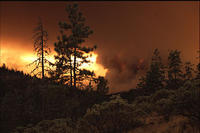-
NIST: Joplin tornado highlights need for building design, construction standards
Nationally accepted standards for building design and construction, public shelters, and emergency communications can significantly reduce deaths and the steep economic costs of property damage caused by tornadoes. That is the key conclusion of a two-year technical NIST investigation into the impacts of the 22 May 2011 tornado that struck Joplin, Missouri. Report and recommendations released for public comment.
-
-
List of most-at-risk L.A. buildings to be released
Scientists have compiled a list of concrete buildings in Los Angeles which could be at risk of collapsing in a major earthquake. The list identifies about 1,500 concrete structures built before 1980 which need further study to determine their risk level. Structural engineers insist that hundreds could die if any of the buildings collapsed.
-
-
Sea-level rise could exceed one meter in this century: experts
Sea-level rise in this century is likely to be 70-120 centimeters by 2100 if greenhouse-gas emissions are not mitigated, a broad assessment of the most active scientists who research in the area, and who are the most prolific publishers on that topic, has revealed. In contrast, for a scenario with strong emissions reductions, experts expect a sea-level rise of 40-60 centimeters by 2100. Ninety international experts, all of whom published at least six peer-reviewed papers on the topic of sea-level during the past five years, provided their probabilistic assessment.
-
-
Understanding Greenland Ice Sheet melting helps sea-level forecasts
New insight into how glacier movement is affected by melting ice in summer could help predictions of sea level rise. In 2012, an exceptionally warm summer caused the Greenland Ice Sheet to undergo unprecedented rates of melting. Researchers have found, however, that fast summer ice flow caused by significant melting is cancelled out by slower motion the following winter.
-
-
Winners announced in NY, NJ coastal protection ideas competition
Ten of the ideas submitted to the Rebuild by Designcompetition, launched by the Hurricane Sandy Rebuilding Task Force, were selected as the most promising concepts for sustainable ways to protect Sandy-affected regions from future catastrophes.
-
-
Smaller asteroids could cause bigger problems

On 15 February an asteroid burst over the Russian city of Chelyabinsk. Scientists estimate that the Chelyabinsk event was equivalent to an explosion of about 500 kilotons of TNT. At its peak, the airburst appeared to be thirty times brighter than the sun. The asteroid fireball that injured about 1,500 people and damaged more than 7,000 buildings, collapsing roofs, and breaking thousands of windows. Scientists say that because the frequency of a strike of an asteroid of this size has exceeded expectations, with three such strikes in just over a century – Chelyabinsk in 2013, Tunguska in 2008, and a large airburst in the South Atlantic in 1963 — the number of similar-sized asteroids capable of causing damage may be greater than suspected.
-
-
Study finds more spending on fire suppression may lead to bigger fires
Researchers found that fire management can fall into the firefighting trap: Energy and resources are spent mostly on fire suppression — putting out fires in the moment — while less attention is devoted to fire prevention, such as clearing brush and building fire lanes during the off-season. After severe fires, policymakers funnel even more funds into fire suppression for the next season, but this attention to fire suppression may undermine prevention efforts. The result, counterintuitively, is even worse fires the following season, due to the buildup of fire-prone materials such as dried tinder and dead trees. The researchers emphasize balancing fire suppression with prevention measures.
-
-
Evacuation modeling: finding the best time (and way) to get going
Reports from the Philippines reveal a lack of typhoon preparation and evacuation efforts. When to evacuate — and how – could spell the difference between life and death. Typhoons can cause widespread flooding of surrounding areas, and do not just affect what lies in the path of the storm. Planning an evacuation is a game against nature. Few plans are safe, and the number and complexity of decisions quickly becomes overwhelming — especially as rising water or traffic accidents block roads — but computers can dramatically help emergency services design evacuation plans which people can actually follow.
-
-
Detecting radioactive material in nuclear waste water
As the Fukushima crisis continues to remind the world of the potential dangers of nuclear disposal and unforeseen accidents, scientists are reporting progress toward a new way to detect the radioactive materials uranium and plutonium in waste water.
-
-
Global disaster recovery as a service: market trends 2014-18
Reportstack has announced a new market report on Global Disaster Recovery-as-a-Service Market 2014-2018, which forecasts that the market is expected to grow at a CAGR of 54.64 percent over the period 2014-2018.
-
-
New drone to monitor radiation following nuclear disasters

Researchers have unveiled a large semi-autonomous drone called the ARM system which could be used to provide visual and thermal monitoring of radiation after a release of nuclear material. The system was developed in response to requirements for radiation monitoring in event of the release of radioactive materials.
-
-
Forecasting long-lived wildfires

Scientists have developed a new computer modeling technique that offers the promise, for the first time, of producing continually updated daylong predictions of wildfire growth throughout the lifetime of long-lived blazes. The technique combines cutting-edge simulations portraying the interaction of weather and fire behavior with newly available satellite observations of active wildfires.
-
-
The Philippines is victim of geography, poor infrastructure, poverty
Owing to its location and geography, the Philippines is one of the most natural disaster-prone countries in the world. On average the country experiences nine major typhoons and 900 earthquakes annually, and it has twenty-five active volcanoes. Poor infrastructure and pervasive poverty exacerbate the impact of disasters, making them even more deadly and destructive. “In a cruel cycle, poverty and underdevelopment make disasters worse, and disasters make poverty and underdevelopment worse,” one observer notes.
-
-
Past as prologue: Insights from past natural disasters relevant today
The increasing frequency and intensity of natural disasters constitute a daunting challenge to modern society, which is characterized by a heavy infrastructure and increasing population density. Until now, coping with natural disasters has involved expensive state intervention and technology-aided approaches, but researchers believes that the past contains a wealth of unexploited resources which could also provide solutions to the problems communities face when dealing with need to cope with, and recover from, natural disasters.
-
-
Japan hopes off-shore wind turbines can replace shut-down nukes

Japan inaugurated a floating offshore wind turbine on Monday, symbolizing the country’s effort to reduce its dependency on nuclear energy and fossil fuels and shift to renewable energy sources. The floating platform is anchored thirteen miles offshore from the Fukushima Daiichi nuclear power plant, which has been out of commission since the reactor’s meltdown disasterof March 2011. The platform is anchored to the seabed 400 feet below surface. It is the first project of its kind in Japan, and it aims to show that the country can exploit the country’s powerful offshore winds to create a sustainable energy source.
-
More headlines
The long view
Using Drone Swarms to Fight Forest Fires
Forest fires are becoming increasingly catastrophic across the world, accelerated by climate change. Researchers are using multiple swarms of drones to tackle natural disasters like forest fires.
How Climate Change Will Affect Conflict and U.S. Military Operations
“People talk about climate change as a threat multiplier,” said Karen Sudkamp, an associate director of the Infrastructure, Immigration, and Security Operations Program within the RAND Homeland Security Research Division. “But at what point do we need to start talking about the threat multiplier actually becoming a significant threat all its own?”
